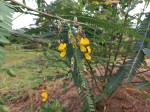Sesbania macrantha
levis
Selected images: Click on each image to see a larger version and details of the record View all images (7)
Habit
Riverine margins and wet swampy grounds
Dabuyu Farms, Lilayi, Lusaka District
Mar 2023
Photo: Nick Wightman
Leaves
Riverine margins and wet swampy grounds
Dabuyu Farms, Lilayi, Lusaka District
Mar 2023
Photo: Nick Wightman
Inflorescence
Riverine margins and wet swampy grounds
Dabuyu Farms, Lilayi, Lusaka District
Mar 2023
Photo: Nick Wightman
Flower
Riverine margins and wet swampy grounds
Dabuyu Farms, Lilayi, Lusaka District
Mar 2023
Photo: Nick Wightman
Flower
Riverine margins and wet swampy grounds
Dabuyu Farms, Lilayi, Lusaka District
Mar 2023
Photo: Nick Wightman
Flower
Riverine margins and wet swampy grounds
Dabuyu Farms, Lilayi, Lusaka District
Mar 2023
Photo: Nick Wightman
Leaf
Riverine margins and wet swampy grounds
Dabuyu Farms, Lilayi, Lusaka District
Mar 2023
Photo: Nick Wightman
Detailed records: Display species records QDS maps by: Google Maps Point records by Google Maps
Species details: Click on each item to see an explanation of that item (Note: opens a new window)
| Synonyms: | |
| Common names: | |
| Frequency: | |
| Status: | Native |
| Description: |
Softly woody herb, slender shrub or small tree, (1)2–6 m tall; glabrous throughout except for the calyx margin and inner surface of the calyx teeth. Stems greyish-green often tinged purplish-black, aculeate or completely without prickles. Leaves up to 45 cm long, the rachis aculeate or not; petioles up to 3.5 cm long; leaflets in 9–64 pairs, 0.7–4.4 cm × 2.5–13 mm (the basal pair sometimes much smaller than the others), oblong, obtuse to slightly emarginate at the apex, apiculate, slightly asymmetrical at the base, entire; stipules 0.9–2.9 cm × 2–5 mm, lanceolate to ovate-lanceolate, acuminate, slightly falcate, erect, caducous or occasionally rather persistent. Raceme 6.3–27.2 cm long (especially long in E Zimbabwe), 5–21-flowered; peduncle 1.6–10 cm long, aculeate (sometimes so densely so that the prickles fuse to form dentate ridges) or completely without prickles. Calyx 5–12 × 6–10 mm, the teeth 1–2 mm long, broadly acuminate. Standard deep yellow, flecked or spotted with violet or purple on the outer face, 1.6–2.6 × 1.7–2.5 cm, the blade first widening gradually from the claw and then very abruptly so that it is subcordate just below the middle, apically emarginate, appendages semicircular or broadly triangular and without free tips; wings yellow, 1.3–2.1 cm × 4–9 mm, with upper basal acuminate tooth slightly hooked or ± horizontal and with lamellate sculpturing in upper basal and central sections on outer face; keel greenish-yellow, slightly speckled with purple, 1.3–1.6 cm × 7.5–11 mm, the basal tooth usually large, horizontal, ± parallel to the petal-claw. Pod 14.5–31 cm × 3.5–8 mm, curved, long acuminate, thicker at the centre than at the sutures which are sometimes slightly constricted between the seeds particularly along the upper margin, 12–30-seeded. Seeds dark olive-brown to almost black, not mottled, 6–8 × 2.5–3.5 mm, 2–3 mm thick, subcylindrical to cylindrical; hilum in ± central circular pit surrounded by a white rim aril. |
| Type location: |
Zimbabwe |
| Notes: | |
| Derivation of specific name: | macrantha: large-flowered levis: smooth, alluding to the absent of prickles |
| Habitat: | |
| Altitude range: (metres) | |
| Flowering time: | Apr - Jul |
| Worldwide distribution: | West Africa, Cameroon, DRC, Tanzania, Angola, Zambia Malawi, Mozambique, Zimbabwe and South Africa |
| FZ divisions: | C,S |
| Growth form(s): | Tree, shrub over 2 m. |
| Endemic status: | |
| Red data list status: | |
| Insects associated with this species: | |
| Spot characters: | Display spot characters for this species |
| Literature: |
Brummitt, R.K., Harder, D.K., Lewis, G.P., Lock, J.M., Polhill, R.M. & Verdcourt, B. (2007). Leguminosae Subfamily Papilionoideae Flora Zambesiaca 3(3) Pages 231 - 233. Coates Palgrave, M. (1989). Guide to the trees and shrubs of the Mukuvisi Woodlands ?publisher. Page 41. as Sesbania macrantha Drummond, R.B. (1972). A list of Rhodesian Legumes. Kirkia 8(2) Page 226. Drummond, R.B. (1975). A list of trees, shrubs and woody climbers indigenous or naturalised in Rhodesia. Kirkia 10(1) Page 245. Mapaura, A. & Timberlake, J. (eds) (2004). A checklist of Zimbabwean vascular plants Southern African Botanical Diversity Network Report No. 33 Sabonet, Pretoria and Harare Page 51. Ntore, S. & al. (2024). Checklist of the vascular plants of Burundi Page 133. |
Other sources of information about Sesbania macrantha var. levis:
Our websites:
Flora of Burundi: Sesbania macrantha var. levisFlora of Mozambique: Sesbania macrantha var. levis
Flora of Zambia: Sesbania macrantha var. levis
Flora of Zimbabwe: Sesbania macrantha var. levis
Flora of Zimbabwe: cultivated Sesbania macrantha var. levis
External websites:
African Plants: A Photo Guide (Senckenberg): Sesbania macranthaAfrican Plant Database: Sesbania macrantha
BHL (Biodiversity Heritage Library): Sesbania macrantha
EOL (Encyclopedia of Life): Sesbania macrantha
GBIF (Global Biodiversity Information Facility): Sesbania macrantha
Google: Web - Images - Scholar
iNaturalist: Sesbania macrantha
IPNI (International Plant Names Index): Sesbania macrantha
JSTOR Plant Science: Sesbania macrantha
Mansfeld World Database of Agricultural and Horticultural Crops: Sesbania macrantha
Plants of the World Online: Sesbania macrantha
Tropicos: Sesbania macrantha
Wikipedia: Sesbania macrantha






